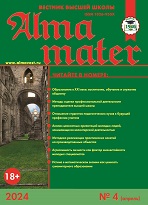UDC 37.09
https://doi.org/10.20339/AM.06-20.031
N.I. Lobanova is Cand.Sci. (Philosophy), doc.; and L.V. Logunova is Cand.Sci. (Philosophy), doc. at Krasnoyarsk State Pedagogical University n.a. V.P. Astafiev e-mail: nanakrasnoyarsk@yandex.ru
Presented are results of the mini-poll “Sums of school education through the eyes of students”. Based on the data collected, it is concluded, that secondary school students are well-formed, along with the set of competencies, unforeseen skills and abilities, planned by the federal educational standard. It has been revealed, that the latter are a “by-product of training” and can be designated as “shadow” competencies. It is determined, that “shadow” competencies are not homogeneous and are divided into two groups: disciplinary and subversive. An analysis of these varieties of competencies is presented, during which it is established that both disciplinary and subversive competencies are formed due to the presence and functioning of a hidden curriculum. The correlation and interconnection of the official curriculum and the hidden curriculum are analyzed. It is shown that, despite the discrepancy between the academic (prescribed in the federal educational standard) learning outcomes and its by-products, there is no contradiction in the interaction of the official curriculum and the hidden curriculum (as well as the educational institution as a whole): they both serve to reproduce cultural and social differences between classes in order to maintain the existing social order. It was revealed that this goal is achieved through the implementation of the functions of the hidden curriculum, which it carries out through the formation of “shadow” competencies: socializing (disciplinary competencies) and selective (subversive competencies) applied to different groups of students.
Key words: hidden curriculum, federal educational standard, “shadow” competencies, subversive competencies, disciplinary competencies, official curriculum.
References
1. Bourdieu, P., Passeron, J.-K. Reproduction: elements of the theory of education. URL: http://bourdieu.name/files/bourdieu_passeron_reproduction_ru_isbn_5090141045.pdf
2. Jackson, F. Life in the classroom. URL: https://www.eseur.ru/Files/file8701.pdf
3. Dudina, V. I. Expert cultures and hidden curriculum in higher education. URL: https://cyberleninka.ru/article/n/ekspertnye-kultury-i-skrytaya-uchebnaya-programma-v-vysshem-obrazovanii
4. Nechitailo, I.S. Investigation of methods for implementing a hidden curriculum using the method of experimental lectures. URL: file:///C:/Users/%D0%9D%D0%B8%D0%BD%D0%B0/Downloads/Npchdusoc_2015_258_246_7%20(2).pdf
5. Polonnikov, A.A. “Hidden curriculum” and productivity of education. URL: https://cyberleninka.ru/article/n/hidden-curriculum-i-produktivnost-obrazovaniya
6. Sorokin, P. Social stratification and mobility. URL: https://sociology.knu.ua/sites/default/files/library/elclosed/sorokin.pdf
7. Tyagunova, T.V. “What the hell is going on there?”: educational practices and research policies. URL: http://elib.bsu.by/bitstream/123456789/43185/1/%d0%94%d0%b8%d1%81%d0%ba%d1%83%d1%80%d1%81%20%d1%83%d0%bd%d0%b8%d0%b2%d0%b5%d1%80%d1%81%d0%b8%d1%82%d0%b5%d1%82%d0%b0%202011%2014-38.pdf
8. FGOS of secondary general education (approved by the order of the Ministry of education and science of the Russian Federation, dated October 6, 2009. No. 413). URL: file:///C:/Users/%D0%9D%D0%B8%D0%BD%D0%B0/Downloads/fgos_ru_sred.pdf%20(6).pdf
9. Yarskaya-Smirnova, E.R. Hidden curriculum as a tradition of sociological research. In: Changing youth in a changing world: invisible everyday life. Ulyanovsk, 2006. P. 95–204.
10. Balucanag, M.A., Thaworn, L. Hidden curriculum and English learning: a case study of a Thai nursing college. URL: https:/pdfs.semanticscholar.orga017/49a7f1233a2837a41a5ab245d26b5939282e.pdf
11. Bray, M., Kobakhidze, M.N., Zhang, W. The hidden curriculum in a hidden marketplace: relationships and values in Cambodia's shadow education system. URL: https://www.researchgate.net/profile/Magda_Nutsa_Kobakhidze/publication/324636059_The_hidden_curriculum_in_a_hidden_marketplace_relationships_and_values_in_Cambodia's_shadow_education_system/links/5ad98435aca272fdaf821219/The-hidden-curriculum-in-a-hidden-marketplace-relationships-and-values-in-Cambodias-shadow-education-system.pdf
12. Larson, J.O. Fatima’s rules and other elements of an unintended chemistry curriculum. URL: https://files.eric.ed.gov/fulltext/ED387318.pdf
13. Matusov, E., Sullivan, P. Pedagogical violence. URL: http://ematusov.soe.udel.edu/vita/Articles/Matusov%20Sullivan%20Pedagogical%20violence%20IPBS,%202019.pdf
14. Perpignan, H., Rubin, B., Katznelson, H. “By-products”: The added value of academic writing instruction for higher education. URL: https://www.sciencedirect.com/science/article/abs/pii/S1475158507000185?via%3Dihub
15. Fulya, D.K. Comparison of hidden curriculum theories. URL: file:///C:/Users/%D0%9D%D0%B8%D0%BD%D0%B0/Downloads/7275c2c3f5f176ee42d8e661ebdb4683e959.pdf











.png)






